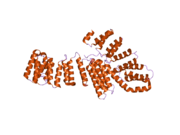From Wikipedia, the free encyclopedia
Protein-coding gene in the species Homo sapiens
Cleavage stimulation factor 77 kDa subunit is a protein that in humans is encoded by the CSTF3 gene .[ 5] [ 6]
The protein encoded by this gene is one of three (including CSTF1 and CSTF2 ) cleavage stimulation factors that combine to form the cleavage stimulation factor complex (CSTF). This complex is involved in the polyadenylation and 3' end cleavage of pre-mRNAs . The encoded protein functions as a homodimer and interacts directly with both CSTF1 and CSTF2 in the CSTF complex. Alternative splicing results in multiple transcript variants encoding different isoforms.[ 6]
CSTF3 has been shown to interact with CSTF2 .[ 7]
Takagaki Y, Manley JL (1992). "A human polyadenylation factor is a G protein beta-subunit homologue" . J. Biol. Chem . 267 (33): 23471–4. doi :10.1016/S0021-9258(18)35861-7 PMID 1358884 . Takagaki Y, MacDonald CC, Shenk T, Manley JL (1992). "The human 64-kDa polyadenylylation factor contains a ribonucleoprotein-type RNA binding domain and unusual auxiliary motifs" . Proc. Natl. Acad. Sci. U.S.A . 89 (4): 1403–7. Bibcode :1992PNAS...89.1403T . doi :10.1073/pnas.89.4.1403 PMC 48459 PMID 1741396 . Murthy KG, Manley JL (1995). "The 160-kD subunit of human cleavage-polyadenylation specificity factor coordinates pre-mRNA 3'-end formation" . Genes Dev . 9 (21): 2672–83. doi :10.1101/gad.9.21.2672 PMID 7590244 . Takagaki Y, Manley JL (2000). "Complex protein interactions within the human polyadenylation machinery identify a novel component" . Mol. Cell. Biol . 20 (5): 1515–25. doi :10.1128/MCB.20.5.1515-1525.2000 . PMC 85326 PMID 10669729 . Emili A, Schieltz DM, Yates JR, Hartwell LH (2001). "Dynamic interaction of DNA damage checkpoint protein Rad53 with chromatin assembly factor Asf1" . Mol. Cell . 7 (1): 13–20. doi :10.1016/S1097-2765(01)00150-2 PMID 11172707 . Benoit B, Juge F, Iral F, et al. (2002). "Chimeric human CstF-77/Drosophila Suppressor of forked proteins rescue suppressor of forked mutant lethality and mRNA 3' end processing in Drosophila" . Proc. Natl. Acad. Sci. U.S.A . 99 (16): 10593–8. Bibcode :2002PNAS...9910593B . doi :10.1073/pnas.162191899 PMC 124984 PMID 12149458 . Strausberg RL, Feingold EA, Grouse LH, et al. (2003). "Generation and initial analysis of more than 15,000 full-length human and mouse cDNA sequences" . Proc. Natl. Acad. Sci. U.S.A . 99 (26): 16899–903. Bibcode :2002PNAS...9916899M . doi :10.1073/pnas.242603899 PMC 139241 PMID 12477932 . Kaufmann I, Martin G, Friedlein A, et al. (2005). "Human Fip1 is a subunit of CPSF that binds to U-rich RNA elements and stimulates poly(A) polymerase" . EMBO J . 23 (3): 616–26. doi :10.1038/sj.emboj.7600070 . PMC 1271804 PMID 14749727 . Gerhard DS, Wagner L, Feingold EA, et al. (2004). "The status, quality, and expansion of the NIH full-length cDNA project: the Mammalian Gene Collection (MGC)" . Genome Res . 14 (10B): 2121–7. doi :10.1101/gr.2596504 . PMC 528928 PMID 15489334 . Kim J, Bhinge AA, Morgan XC, Iyer VR (2005). "Mapping DNA-protein interactions in large genomes by sequence tag analysis of genomic enrichment". Nat. Methods . 2 (1): 47–53. doi :10.1038/nmeth726 . PMID 15782160 . S2CID 6135437 . Rual JF, Venkatesan K, Hao T, et al. (2005). "Towards a proteome-scale map of the human protein-protein interaction network". Nature . 437 (7062): 1173–8. Bibcode :2005Natur.437.1173R . doi :10.1038/nature04209 . PMID 16189514 . S2CID 4427026 . Taylor TD, Noguchi H, Totoki Y, et al. (2006). "Human chromosome 11 DNA sequence and analysis including novel gene identification" . Nature . 440 (7083): 497–500. Bibcode :2006Natur.440..497T . doi :10.1038/nature04632 PMID 16554811 . Olsen JV, Blagoev B, Gnad F, et al. (2006). "Global, in vivo, and site-specific phosphorylation dynamics in signaling networks" . Cell . 127 (3): 635–48. doi :10.1016/j.cell.2006.09.026 PMID 17081983 . S2CID 7827573 . Ewing RM, Chu P, Elisma F, et al. (2007). "Large-scale mapping of human protein-protein interactions by mass spectrometry" . Mol. Syst. Biol . 3 (1): 89. doi :10.1038/msb4100134 . PMC 1847948 PMID 17353931 .








